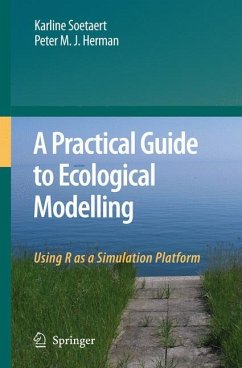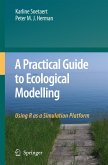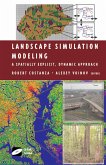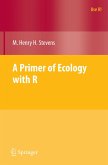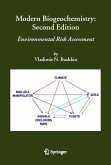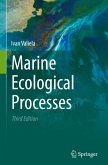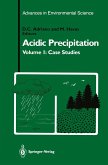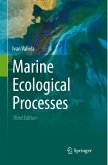Mathematical modelling is an essential tool in present-day ecological research. Yet for many ecologists it is still problematic to apply modelling in their research. In our experience, the major problem is at the conceptual level: proper understanding of what a model is, how ecological relations can be translated consistently into mathematical equations, how models are solved, steady states calculated and interpreted. Many textbooks jump over these conceptual hurdles to dive into detailed formulations or the mathematics of solution. This book attempts to fill that gap. It introduces essential concepts for mathematical modelling, explains the mathematics behind the methods, and helps readers to implement models and obtain hands-on experience. Throughout the book, emphasis is laid on how to translate ecological questions into interpretable models in a practical way.
The book aims to be an introductory textbook at the undergraduate-graduate level, but will also be useful to seduce experienced ecologists into the world of modelling. The range of ecological models treated is wide, from Lotka-Volterra type of principle-seeking models to environmental or ecosystem models, and including matrix models, lattice models and sequential decision models. All chapters contain a concise introduction into the theory, worked-out examples and exercises. All examples are implemented in the open-source package R, thus taking away problems of software availability for use of the book. All code used in the book is available on a dedicated website.
The book aims to be an introductory textbook at the undergraduate-graduate level, but will also be useful to seduce experienced ecologists into the world of modelling. The range of ecological models treated is wide, from Lotka-Volterra type of principle-seeking models to environmental or ecosystem models, and including matrix models, lattice models and sequential decision models. All chapters contain a concise introduction into the theory, worked-out examples and exercises. All examples are implemented in the open-source package R, thus taking away problems of software availability for use of the book. All code used in the book is available on a dedicated website.
Review:
"This is the book many of us were waiting for, maybe for longer than the time since R entered our computational toolbox." ... "To return to my first sentence, yes, this is the book I was waiting for. It exceeds my expectations and it is very practical with an optimal mix of theoretical and numerical topics. It is of particular use for aquatic ecologists, and definitely worth to be considered by ecologists from other fields." ... "One point I very much enjoyed is the link between ecological, chemical and hydrophysical topics. I am not aware of any other book that brings these together in such a concise and understandable way. I completely agree with the authors that "this book is written for young researchers who want to get more out of their data than just description" and I warmly recommend it for all, who are young in mind. It helps to democratise modelling knowledge and provides a highly efficient method to supply ecologists with this urgently needed competence."
© 2009 Thomas Petzoldt
Endorsements:
"This outstanding book provides a comprehensive and extremely clear treatment on the development, implementation, use and testing of ecological models. It embraces and covers the diverse approaches used by ecologists and biogeochemists; e.g. from simple food-web models to time-dependent transport-reaction models. Numerous, instructive examples are provided and implemented in R, a public domain programming language. I have successfully used a draft version for master courses on biogeochemical modeling and strongly recommend it to ecologists and biogeochemists interested to elucidate the functioning of natural ecosystems."
Jack J. Middelburg, Professor in Biogeochemistry and Senior Scientist at the Netherlands Institute of Ecology.
"Soetaert and Herman have provided an unexpected, back-door solution to producing cross-platform, ecological models. Robust, cross-platform statistical packages have beendifficult to find. Moreover, many statisticians are not satisfied with black-box programs whose algorithms they have not checked. To solve both problems simultaneously, many have moved to doing their statistics on the R platform. R is a high-level, open-source programming language strong on both statistical computing and graphic output."
"Commercial providers of modeling software have been far better in providing cross-platform support than have statistical package providers. Mathematica and Stella have focused on user friendliness of basic functions and graphing, making it easy to learn as you go. Matlab has a somewhat steeper learning curve, but is blazingly fast with matrix operations on large data sets and sets of simulated data. All are fairly expensive to license and upgrade. I find R less intuitive than any of these other programs."
"Nevertheless, Soetaert and Herman make a good case for giving R a serious look as a modeling tool for reasons beyond the fact that it is available at no cost. If you have already come in through the back door to R for its statistical uses, then the steep learning-curve argument is behind you. Philosophically and functionally, there is good reason to want to model and analyze statistically in the same environment: Modeling and hypothesis testing both progress fastest when they alternate iteratively. Soetaert and Herman develop a very deliberate set of switchbacks up the learning curve by emphasizing model diversity and relatively easy examples. The examples are the ones that have survived the sometimes brutally Darwinian process of teaching a class based on the draft book. Examples are diverse enough that others can teach from the book and still develop an emphasis of their own choosing."
P. Jumars, Director, School of Marine Sciences, University of Maine
From the reviews:
"An 'introductory text for ecological modelling for graduate and post-graduate students or othersinterested in making more out of their data' ... . This book is an excellent introductory text for mathematical biology ... . It is a good resource for R-code with code for all the examples, figures and analyses being available in the book ... . useful as a reference text introducing new topics and approaches for modelling. The book is well written, as are the mathematical descriptions, the concepts and the R-code." (Louise Emmerson, Austral Ecology, Vol. 36 (e14), 2011)
"This is the book many of us were waiting for, maybe for longer than the time since R entered our computational toolbox." ... "To return to my first sentence, yes, this is the book I was waiting for. It exceeds my expectations and it is very practical with an optimal mix of theoretical and numerical topics. It is of particular use for aquatic ecologists, and definitely worth to be considered by ecologists from other fields." ... "One point I very much enjoyed is the link between ecological, chemical and hydrophysical topics. I am not aware of any other book that brings these together in such a concise and understandable way. I completely agree with the authors that "this book is written for young researchers who want to get more out of their data than just description" and I warmly recommend it for all, who are young in mind. It helps to democratise modelling knowledge and provides a highly efficient method to supply ecologists with this urgently needed competence."
© 2009 Thomas Petzoldt
Endorsements:
"This outstanding book provides a comprehensive and extremely clear treatment on the development, implementation, use and testing of ecological models. It embraces and covers the diverse approaches used by ecologists and biogeochemists; e.g. from simple food-web models to time-dependent transport-reaction models. Numerous, instructive examples are provided and implemented in R, a public domain programming language. I have successfully used a draft version for master courses on biogeochemical modeling and strongly recommend it to ecologists and biogeochemists interested to elucidate the functioning of natural ecosystems."
Jack J. Middelburg, Professor in Biogeochemistry and Senior Scientist at the Netherlands Institute of Ecology.
"Soetaert and Herman have provided an unexpected, back-door solution to producing cross-platform, ecological models. Robust, cross-platform statistical packages have beendifficult to find. Moreover, many statisticians are not satisfied with black-box programs whose algorithms they have not checked. To solve both problems simultaneously, many have moved to doing their statistics on the R platform. R is a high-level, open-source programming language strong on both statistical computing and graphic output."
"Commercial providers of modeling software have been far better in providing cross-platform support than have statistical package providers. Mathematica and Stella have focused on user friendliness of basic functions and graphing, making it easy to learn as you go. Matlab has a somewhat steeper learning curve, but is blazingly fast with matrix operations on large data sets and sets of simulated data. All are fairly expensive to license and upgrade. I find R less intuitive than any of these other programs."
"Nevertheless, Soetaert and Herman make a good case for giving R a serious look as a modeling tool for reasons beyond the fact that it is available at no cost. If you have already come in through the back door to R for its statistical uses, then the steep learning-curve argument is behind you. Philosophically and functionally, there is good reason to want to model and analyze statistically in the same environment: Modeling and hypothesis testing both progress fastest when they alternate iteratively. Soetaert and Herman develop a very deliberate set of switchbacks up the learning curve by emphasizing model diversity and relatively easy examples. The examples are the ones that have survived the sometimes brutally Darwinian process of teaching a class based on the draft book. Examples are diverse enough that others can teach from the book and still develop an emphasis of their own choosing."
P. Jumars, Director, School of Marine Sciences, University of Maine
From the reviews:
"An 'introductory text for ecological modelling for graduate and post-graduate students or othersinterested in making more out of their data' ... . This book is an excellent introductory text for mathematical biology ... . It is a good resource for R-code with code for all the examples, figures and analyses being available in the book ... . useful as a reference text introducing new topics and approaches for modelling. The book is well written, as are the mathematical descriptions, the concepts and the R-code." (Louise Emmerson, Austral Ecology, Vol. 36 (e14), 2011)

